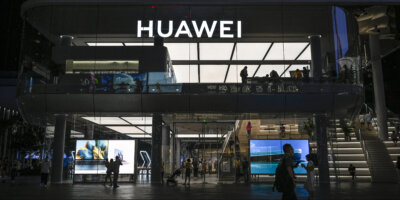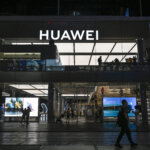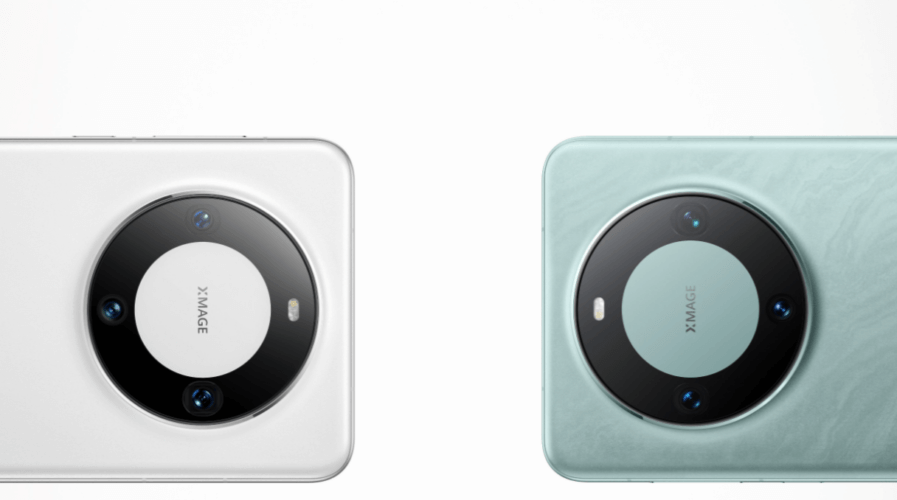
Huawei said the Mate 60 Pro is the “most powerful Mate model ever,” without mentioning its CPU or the handset’s 5G connectivity. Source: Huawei’s website
Huawei Mate 60 Pro: Everything we know about the new 5G Kirin chipset
- Huawei said the Mate 60 Pro is the “most powerful Mate model ever,” without mentioning its CPU or the handset’s 5G connectivity.
- Chinese benchmarking website AnTuTu has identified the Mate 60 Pro’s CPU as the HiSilicon-designed Kirin 9000s, which supports 5G.
- Questions remain over whether the Mate 60 Pro is a domestic workaround of US sanctions.
Amid all the talk that Huawei Technologies Co may make a comeback in the global 5G smartphone race, the Chinese telecommunications giant quietly launched a new smartphone – the Mate 60 Pro. At first look, the Mate 60 Pro looks like any other Chinese phone, with advancements that set it apart from its predecessor. By the time local reviews started pouring in, talk was mainly focused on the phone’s shockingly impressive network speeds – speeds that match a typical 5G chip-powered smartphone.
First, it is fair to note that despite rumors, Huawei had denied planning 5G phone releases, citing US sanctions. But then the Mate 60 Pro release last week, unaccompanied by any huge teaser campaign or major event, as Huawei would usually organize for a major launch, raised eyebrows.
To top it off, Huawei declined to provide details about the handset’s processor – or whether it supports 5G mobile networks – during the launch.
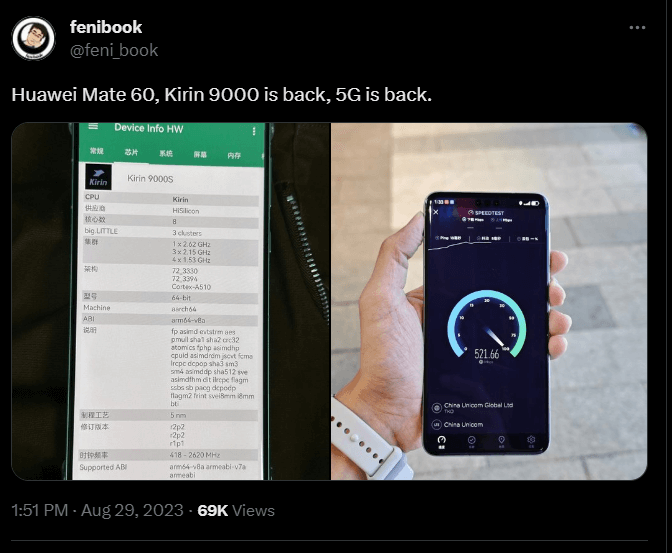
Some users tested the speed of mobile Internet and found that it was higher than on smartphones with support for 4G networks only. Source: Twitter
Industry analysts and consumers didn’t take long before they began speculating on the embattled Chinese giant’s unlikely behavior.
The launch, intentionally or otherwise, coincided with US Commerce Secretary Gina Raimondo’s visit to China last week. Raimondo’s visit was the fourth high-level US official to visit China this summer, as the relationship between the nations has grown increasingly intense.
Chinese state media declared the timing of the phone announcement was a show of defiance, indicating to the US that the trade war was a “failure.” Not too long after speculation on this point began in China, there were hushed concerns in Washington, too. Countless reports suggested that the US sanctions had manifestly failed to prevent China from making a critical technological advance.
It seemed that, for now at least, the US chipmakers were right when they warned that far-reaching sanctions would not stop China, but instead spur it to redouble its efforts to build alternatives to US technology.
Details on the Huawei Mate 60 Pro
Details regarding the device’s processor and network support were notably absent from the published spec sheet, leaving consumers and industry watchers curious about the device’s true capabilities. Yet, many local reviewers claimed that the phone reached 5G speeds. The only giveaway from Huawei, based on its statement on August 29, was a statement that the Mate 60 Pro was the “most powerful Mate model ever,” with no mention of its CPU or the handset’s 5G connectivity.
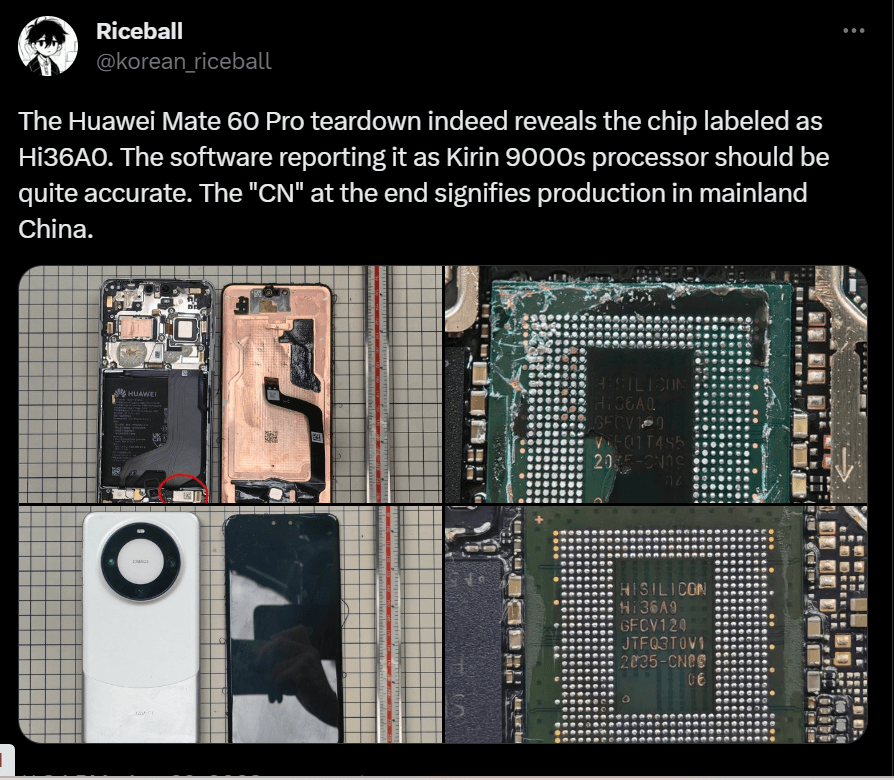
The Huawei Mate 60 Pro teardown proves the speculation to be right. Source: Twitter
Based on tests, the Chinese benchmarking website AnTuTu identified the central processing unit (CPU) in the Mate 60 Pro as the Kirin 9000s from Huawei’s chip design unit, HiSilicon. The CPU has a 12-core configuration and a top clock speed of 2.62 gigahertz, according to AnTuTu. For context, Shenzhen-based Huawei and its chip design arm HiSilicon were added to the US government’s trade blacklist, known as the Entity List, in 2019.
Tightened US restrictions imposed in 2020 restrict Huawei from obtaining advanced integrated circuits (ICs) from major contract chipmakers, such as Taiwan Semiconductor Manufacturing Co. or Samsung Electronics. Although HiSilicon’s website did not provide information about that CPU, the firm’s existing Kirin 9000 and 9000e chipsets support 5G connectivity and artificial intelligence applications. They are built on the advanced 5nm manufacturing process.
The Mate 40 series, released in October 2020, was the last 5G smartphone launched by Huawei, which used the HiSilicon-designed Kirin 9000 system-on-a-chip in the device. “The new Mate’s download speeds can reach 500 megabits per second, which exceeds the 100Mbps speed requirements for 4G networks, according to independent tests run by some consumers,” the South China Morning Post (SCMP) wrote.
China’s official broadcaster, CGTN, in a post on X, called the phone Huawei’s “first higher-end processor” since US sanctions were imposed, and said the chip it contains was made by Semiconductor Manufacturing International Corp, a company partially owned by the Chinese government.
Separately, Nikkei Asia reported that SMIC would be using what’s known as the “7nm process” to make the chips for Huawei, the most advanced level in China.
In simple terms, that’s on par with the process used for the chips inside Apple’s iPhones launched in 2018. The Taiwan Semiconductor Manufacturing Company made the latest iPhone chips using what is known as the 4nm process. As for the graphics processing unit in the new Mate, AnTuTu identified it as another Chinese-designed chip, the Maleoon 910.
READ MORE
- 3 Steps to Successfully Automate Copilot for Microsoft 365 Implementation
- Trustworthy AI – the Promise of Enterprise-Friendly Generative Machine Learning with Dell and NVIDIA
- Strategies for Democratizing GenAI
- The criticality of endpoint management in cybersecurity and operations
- Ethical AI: The renewed importance of safeguarding data and customer privacy in Generative AI applications





